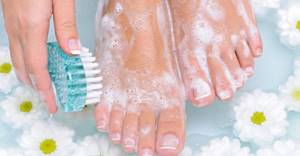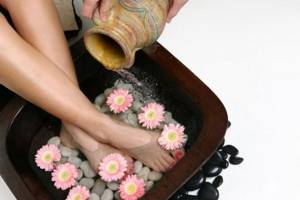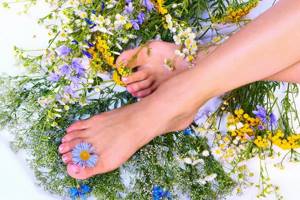Foot skin care is an important and necessary part of a regular self-care routine, which many often forget about or do not pay due attention to. Meanwhile, it is our legs that help us move every day, bearing for hours the heavy load from walking and running and the weight of our body. Improper or insufficient foot care can lead to the formation of calluses, corns, cracked heels and ingrown toenails. Many women remember the need for a pedicure in the summer, when it’s time to change into open shoes and sandals or prepare for the beach season, when you need to take care of your feet all year round. However, everyone needs to know how to care for the skin of their legs - this not only helps for aesthetically attractive legs, but also prevents many unpleasant and painful conditions.
Foot care usually takes much less time than facials and manicures, and a pedicure every 2-3 weeks is usually enough to keep your feet in good condition. Many salons are ready to provide their pedicure services for a reasonable fee for those who are not ready to spend their free time and buy care products for a home pedicure. For those who are not ready to resort to the help of specialists and are interested in how to care for their feet at home, there are tips and rules for caring for the skin and nails of the feet.
How to care for your feet
The skin on the soles of our feet is the driest part of our body. In addition to the fact that there are no sebaceous glands, the skin of the feet contains many sweat glands. Most of the time, your feet not only receive a lot of stress from walking and running, but they also sit in shoes that can vary greatly in quality of materials, comfort and condition. With age, the skin of the feet becomes significantly rougher and loses moisture, becoming even more vulnerable. All this often leads to various problems with the skin of the legs, which most often appear on the feet.
The most basic rule for caring for the skin of your feet is foot hygiene. Feet should not only be washed and cleaned regularly, but also try to be kept dry. To do this, you always need to choose comfortable and high-quality shoes, which also need to be kept clean not only on the outside, but also on the inside - even if those around you won’t notice it, your feet will thank you. A healthy microflora of your legs and feet will help you avoid many diseases and unpleasant cosmetic problems, but any problem is easier to prevent than to fix.
In addition to the obvious rule about washing your feet, you must not forget about moisturizing. In addition to the general tendency of the skin on your feet to become dry, you should not forget that soap can also dry out the skin, and therefore it needs additional moisturizing - at least some areas of it. Use a special foot cream to care for your feet and nails, spreading the product over your legs, avoiding the skin between your toes - this area should always remain dry. Using light massaging movements, distribute the cream from fingers to ankle. If your feet are tired during the day and you want to let them rest even more, it is recommended to use cool foot baths before applying the cream. It is worth remembering that the water should be cool, not icy - it is enough that the water temperature is several degrees lower than your body temperature. Immerse your legs in the pelvis up to ankle level and wait 5-10 minutes - this procedure will give your legs lightness and relieve tension and fatigue.
It is best to apply the cream in the evening, when you don’t have to rush anywhere and have the opportunity not only to let the cream absorb, but also to let your feet rest and relax with the help of the cream and a light massage. This remedy helps fight fatigue and swelling of the legs, normalize metabolism, improve blood circulation and saturate the skin cells of the legs with oxygen. You should apply products and massage your legs, moving from bottom to top, and not vice versa: during the whole day spent on your feet, blood and fluid in the body constantly rush down due to gravity, and a massage from the fingers to the knees can disperse the blood and help not only with the condition of the legs , but also improve vascular health:
- Using your thumbs, press on the center of the foot, knead the arch in a circular motion, gently massage the heels and balls of the feet below the toes;
- Rub your feet with vigorous movements until a surge of warmth flows to your feet;
- Knead the space between your toes and the toes themselves by moving them vigorously. While the arches of the feet and ankles are almost constantly in motion while walking, the toes, especially when wearing tight or uncomfortable shoes, are often practically immobilized and compressed by the toes of shoes or other footwear. Every part of your body requires movement to function properly, so don't forget to stretch.
Foot baths
A hot bath is the fastest and most effective way to moisturize the skin, eliminate swelling, fatigue and heaviness in the legs, and also prepare the feet for cleansing and applying a cream or mask. It is recommended to do baths before bedtime 2-3 times a week.
Herbal bath with honey
Compound:
- 30 g linden blossom;
- 30 g chamomile inflorescences;
- 50 g honey;
- 2 liters of hot water.
Carrying out the procedure:
- Pour 1 liter of hot water over the medicinal raw material and leave for 5–10 minutes.
- Add the remaining water to the herbal infusion and pour the prepared solution into a basin.
- Place your feet in it and hold for 15–20 minutes.
- Treat steamed feet with pumice stone.
Glycerin bath with rose water
Compound:
- 40 g glycerin;
- 50 ml rose water;
- 1 liter of hot water.
Carrying out the procedure:
- Mix rose water with glycerin and pour the resulting solution into a container of hot water.
- Keep your feet in the bath for 15–20 minutes, and then massage your feet and treat them with pumice stone if necessary.
How to care for your heels
Lack of necessary care for the heels of the feet can lead not only to calluses and corns, but also to the formation of cracks - this problem is very painful and requires a lot of time for the skin of the heels to return to normal. To soften your heels and prevent problems, try the following heel care:
- Place your feet in a bath of warm water and bath salts for 5-15 minutes;
- Soak a pumice stone in warm soapy water and gently rub it over your heels and dry areas of your feet;
- Dry your feet with a towel using gentle blotting movements. Do not forget that after steaming in warm water and rubbing with a pumice stone, the skin on your feet becomes sensitive, so avoid rubbing your feet with a hard towel after the procedure;
- To complete your skincare routine, use a moisturizer. Choose a foot care cream that suits you and use it regularly before bed.

Foot hygiene

Feet, like all other parts of the body, have skin that needs daily care. This part of the female body is subjected to quite strong loads, which have a negative effect on both the epidermis and the nails.
Representatives of the fair sex who wear high-heeled shoes every day know that at the end of the working day their feet are very tired and do not smell very pleasant. All this happens due to the fact that the foot is constantly elevated and compressed. Hygiene procedures can help get rid of not entirely pleasant sensations.
Care tips: • Wash your feet every evening with warm water and soap • Remove dead skin particles with a hard washcloth or pumice stone • Wipe the skin thoroughly with a soft towel • Don’t forget to pay attention to the skin between the toes • Apply a nourishing cream to the epidermis • Periodically apply herbal treatments to your feet baths
How to choose the right product to care for your feet
Most products designed to care for dry skin on the feet are quite universal and suitable for everyone without exception. Unlike facial skin, which can be dry, oily or combination, the skin of the feet is always prone to dryness to varying degrees, and therefore moisturizers are suitable for everyone, either to solve existing problems or for prevention. There are products that need to be used daily, and products that are used every few days or even weeks as manicure aids.
Oils
Foot oil and products containing natural vegetable oils help to thoroughly moisturize and soften the skin of the feet and make it more resistant to overload and constant wearing of shoes. To care for the skin of your feet, you can use both specialized oils for the skin of your feet and oils intended for the care of the skin of the whole body. They often contain argan, macadamia, almond and rose oils, shea butter and even some algae.
Milk and creams
Products with plant extracts, thermal water, niacinamide and various oils are well suited for daily foot care. Foot milk and cream is usually very nourishing for the skin and at the same time absorbs well and feels lighter than foot oil. These products are also well suited for foot massages at home.
Gels and scrubs
These products not only intensively moisturize and refresh the skin of your feet, but also help get rid of dry, dead skin particles. The use of scrubs is more gentle than pumice, but in combination with a creamy moisturizing structure it can have a significant effect on dry skin of the feet and at the same time massage the feet. Scrubs are recommended to be used every 3-4 days to keep the skin of your feet smooth and fresh.
Lotions
To keep your skin soft and fresh longer, you need to use lotions with AHA acids or sodium hydroxide, as well as creams with salicylic acid in the composition. Salicylic acid prevents excess production of keratin, which is the main cause of roughening and hardening of the skin of the legs.
Foot Sweat Control Products
Controlling foot sweating is important all year round, but this problem becomes especially urgent in the summer, when it’s hot, and in winter, especially when wearing warm winter shoes indoors for a long time and using low-quality shoes made from “non-breathable” materials. Increased foot sweating can not only lead to the formation of unpleasant odors, but also serve as a breeding ground for bacteria, which often appear in dirty outdoor shoes and multiply in moisture and heat. To control foot sweating, it is necessary to use special deodorants and creams containing deodorizing and antibacterial agents, as well as add extracts and oils to foot baths. Do not forget that you should use foot deodorant, like regular deodorant, only on dry and clean skin.

Foot care at different times of the year
Each season has its own differences when it comes to foot care, as well as key factors that determine the major skin care trends. Let's focus on the basic rules of foot care at different times of the year.
Summer foot care

The main factors that negatively affect the skin of the feet in summer are wind, sand, water and sun. That is, paradoxically, the very things we crave for on vacation. On the one hand, influencing the body to restore the skin from the inside in the summer is much easier due to the abundance of fresh vegetables and fruits rich in vitamins and microelements. However, you shouldn’t forget about the external side of self-care.
- In the summer we wear mainly open shoes, because the skin of the feet is constantly exposed to all of the above factors. In the warm season, feet often need treatment and this process should not be left to chance.
- Sunscreens and lotions will help protect the skin of your legs and thighs from drying out; they also provide an even tan. Never forget to use lotions and milk after sunbathing, otherwise the acquired “sunny” beauty will result in skin irritation.
- Although usually with the onset of summer we switch to lighter and non-greasy creams, this rule does not work for the skin of the feet: foot cream is usually oily and dense.
- In summer, the skin of the feet is most prone to cracking, so you need to have your favorite cream with panthenol, vitamins A and E, placenta and other active regenerants ready, otherwise you can safely forget about an easy walk in beautiful sandals.
- Daily cleansing is one of the main commandments of foot care in the summer. Make it a rule to wash your feet with cool water every time you return home, and you will certainly feel how fatigue and swelling go away along with the dust of the roads.

Summer recipes:
Anti-sweating cream with oak bark decoction Ingredients: 20 g of your favorite foot cream, 30 ml of oak bark decoction, grape seed oil - 5 drops, coconut oil - 5 g. Preparation: mix all ingredients until smooth texture.
Foot cream with mineral water Ingredients: mineral water - 100 ml of water, beeswax - 10 g, oils: olive, coconut, grape seed - 20 drops, essential oils of lavender, tea tree, jasmine - 5 drops. Preparation: mix the ingredients, except essential oils and water, heat in a water bath until completely dissolved. Then add hot mineral water and blend in a blender. After cooling, add essential oils.
Fresh celandine foot mask Ingredients: crushed celandine greens. Preparation: the paste is applied to the feet under a film and a sock overnight. In the morning, the loose skin is washed off with a hard washcloth.
In summer and autumn, toenails grow approximately twice as fast as in spring and autumn.
Foot care in autumn

At this time, the skin is still full of vitamins and has a beautiful tan. It is necessary to maintain this condition for as long as possible in order to create a reserve for the lean winter and spring.
- A summer tan can be maintained for a long time by using peelings and scrubs less intensively.
- Cosmetics with collagen will moisturize the skin well and make it more elastic.
- With the onset of autumn, the skin becomes more vulnerable with the transition to closed shoes, so you can add tea tree oil to baths and creams for disinfection.
- In the fall, you can make nourishing masks for the skin of your feet; doing the procedure 1-2 times a week is enough.
Autumn recipes:
Nourishing cream with calendula (softens even the most problematic skin on the heels) Ingredients: vitamin A oil solution, calendula ointment (purchased at the pharmacy). Preparation: mix vitamin and ointment thoroughly in a ratio of 2: 1. Store in the refrigerator.
Warm foot bath with herbal decoction Ingredients: water (40-45 degrees), calendula, wormwood, St. John's wort, oak bark, coltsfoot - 1 tbsp. Preparation: add a decoction of herbs to the bath, after the procedure, wipe your feet thoroughly, lubricate the skin with warm olive oil.
Mayonnaise for foot skin care Ingredients: olive mayonnaise. Application: apply to feet every day for a week under cellophane and a sock. Lasts until the morning, washed off with warm water without soap. The heels become extremely tender.
Foot care in winter

Winter is a difficult time for your feet. Provided that you dress for the weather, they are perhaps the most successfully protected from the cold, but central heating, which greatly dries out the air, negatively affects the condition of the skin of the feet and can lead to the appearance of cracks. Warm winter shoes increase sweating and increase the risk of ingrown toenails.
- Wear replaceable shoes to work. An eight-hour stay in the office in winter boots with intense heating causes the skin of the feet to sweat and sweat, creating favorable conditions for the proliferation of harmful bacteria.
- Use fatty nourishing creams and masks rich in vitamins A, C, E.
- Don't forget to moisturize your skin with foot creams with extracts of parsley, linden blossom, birch buds and collagen.
- Apply the cream at night under cellophane or a cotton sock. This will allow you to make good use of your night time.
- An emphasis on proper nutrition, rich in vitamins and microelements, is a necessary condition for the health and strength of the skin of your feet.
Winter recipes:
Butter cream (softening) Ingredients: 50 g melted butter or margarine, 1/2 tsp. glycerin oil, 1 tbsp. l. chamomile decoction, 4 tsp. vegetable oil, 30 g camphor alcohol, 2 yolks. Preparation: all ingredients (except chamomile infusion) are melted in a water bath. Decoction of 1 tbsp. l. dry chamomile herb and 100 g of boiling water are brewed and infused for 2 hours. It needs to be filtered and thoroughly mixed with the oil base of the cream. Store in the refrigerator for no more than 3 weeks.
Cabbage compress for cracked heels Ingredients: a leaf of white cabbage is lightly beaten with a hammer to release the juice, and applied to the foot overnight under a film and a sock.
Zucchini mask (tonic) Ingredients: 50 g of grated zucchini, 3 drops of grapefruit essential oil. Preparation: mix the ingredients and apply the mixture to your feet under cellophane and socks. The mask is made for 20 minutes, washed off with warm water.
Pedicure is an important spa treatment
Pedicure at home is carried out in several stages:
- foot baths – popular recipes are described above in the article;
- exfoliation with a scrub or pumice;
- foot massage using cream or oil of natural origin;
- removing cuticles using a wooden stick;
- using tweezers to remove an overgrown nail.
Only after these procedures can you coat the nail with varnish. A careless attitude towards your own legs will lead to their appearance being disgusting. Men should also take care of their feet; it is a mistake to believe that the stronger sex does not need a beautiful manicure.
A specialized spa salon will provide a full-fledged foot care complex. Therefore, many ladies prefer to visit a professional’s office once a month. The main thing is that after the session the client feels complete rest and pleasant sensations in the legs.


![[Photo review] “A Sassy Nation” bodysuit from Black Milk Clothing](https://superlady555.ru/wp-content/uploads/fotoobzor-bodi-a-sassy-nation-ot-black-milk-clothing-330x140.jpg)







